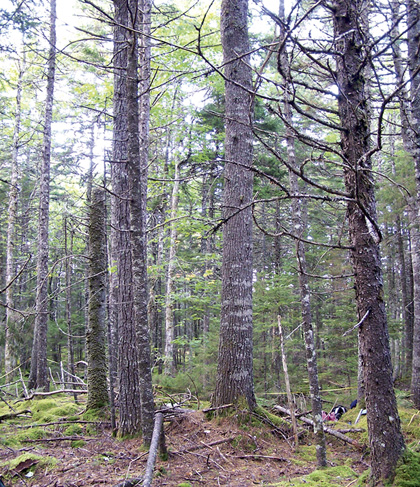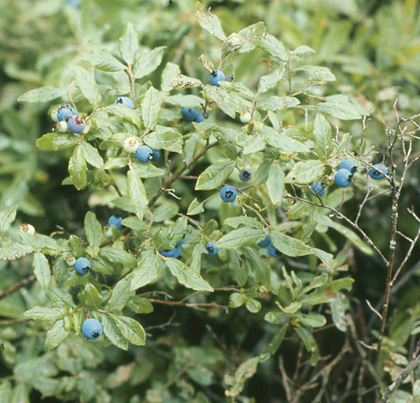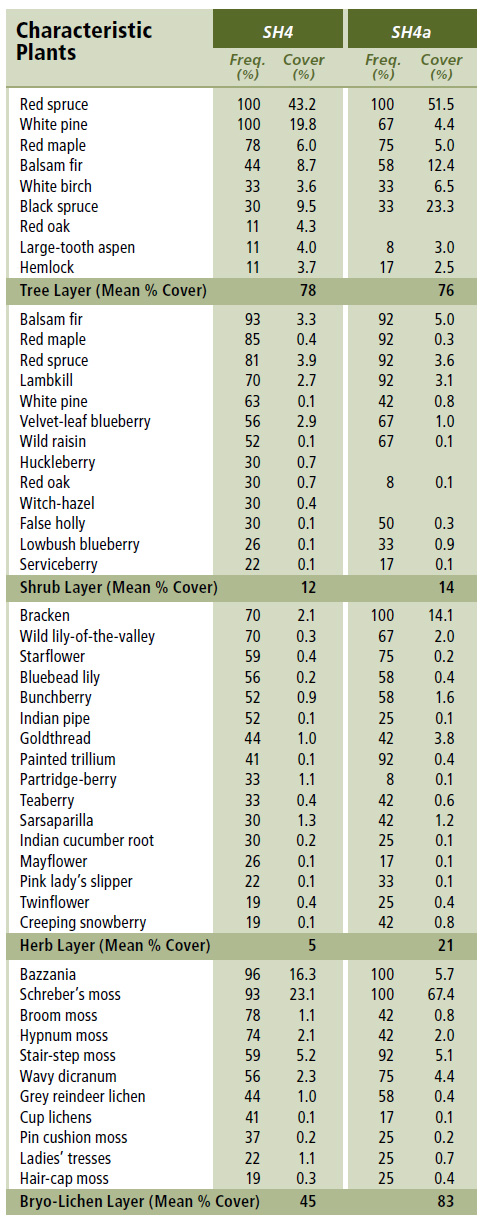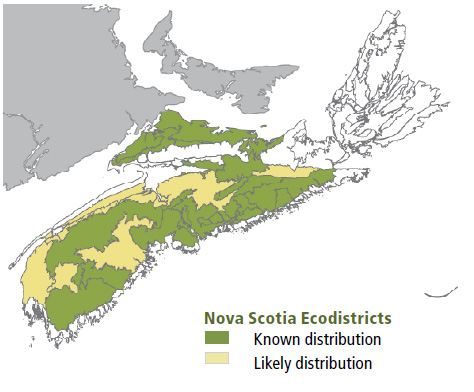
Forest Vegetation types - SH4
SH4 — Red spruce – White pine / Lambkill / Bracken
Picea rubens – Pinus strobus / Kalmia angustifolium / Pteridium aquilinum
SH4a —Red spruce variant
Picea rubens
 |
Sherbrooke Lake, Lunenburg County |
Concept: This late successional Vegetation Type (VT) has abundant red spruce and white pine with minor coverage of other species such as red maple, white birch, black spruce and balsam fir (hemlock is usually absent from this VT). There is one variant (SH4a) where red spruce cover is dominant with only scattered white pine. Red spruce – White pine / Lambkill / Bracken is a typical Acadian softwood VT found on dryer, poorer sites which are bordering on zonal conditions.
Vegetation: Red spruce and white pine are the dominant overstory trees with red maple, balsam fir, and black spruce occasionally co-dominant. Hybridization of red and black spruce is common and creates difficulty in distinguishing these two species. Regenerating balsam fir and red spruce are prominent in the shrub layer along with ericaceous species such as lambkill and blueberry. Overall coverage and diversity of herbs is low with bracken the most prevalent species. (Coverage may be higher in the red spruce variant SH4a.) Bazzania and Schreber's moss are the dominant bryophytes, with small patches of reindeer mosses occurring on drier sites.
Environmental Setting: SH4 is mainly associated with dry to fresh, nutrient poor to medium soils of glacial origin. These soils are generally medium to coarse textured and often stony. This VT is found throughout mainland Nova Scotia and parts of Cape Breton Island. It is relatively common across southern and central New Brunswick but absent from Prince Edward Island.
Successional Dynamics: SH4 is a late successional climatic climax VT dominated by red spruce and white pine. It can develop from early successional VTs including IH1 (Large-tooth aspen / Lambkill / Bracken) and IH2 (Red oak – Red maple / Witch-hazel) and from mid-successional types such as SH5 (Red spruce – Balsam fir / Schreber's moss) and SH9 (Balsam fir - Black spruce / Blueberry). This VT is unlikely to shift to SH3 (Red spruce – Hemlock / Wild lily-of-the-valley) since hemlock prefers sites with greater moisture and fertility. Early successional stages can be by-passed if at the time of disturbance advanced red spruce and white pine regeneration is retained (as could happen after a stand-level disturbance such as windthrow or harvesting). Depending on disturbance history this VT can be even-aged, but it will develop an uneven-aged structure as it matures. Between large-scale disturbance events this unit will be maintained through gap replacement.
Ecological Features: This matrix forest typically occurs over hundreds of hectares. The longevity of red spruce supports old growth development. This tree is very tolerant of understory shade, responding well to release after decades of suppression, whereas white pine, which has only intermediate shade tolerance, requires release at a young age. In old forests, white pine may outlive red spruce, developing a supercanopy, and sometimes hollow, large stemmed trees. Mature forests provide large diameter cavity trees, snags and downed coarse woody material. This forest may provide cover for moose and deer, and habitat for fisher, flying squirrels and red squirrels. coarse woody debris may provide cover for red-backed salamanders and small mammals, while large trees can provide pileated woodpecker, barred owl and northern goshawk nest sites. Boreal chickadee, pine siskin and both the white-winged and red crossbills eat red spruce and white pine seeds. Creeping rattlesnake plantain is the only known rare plant.
 |
| Blueberry |
Distinguishing Features: Red spruce and white pine are the dominant overstory species in this softwood forest. Hybridization of red and black spruce is common. Bracken and ericaceous shrubs such as lambkill and blueberry are indicative of poor and dry conditions. Hemlock is absent. The variant SH4a is similar with reduced levels of white pine.
| Slope Position: | Upper4 Crest2 Level2 Lower1 Middle1 |
Surface Stoniness: |
(Non - Slightly)4 (Very - Excessively)4 (Moderately)2 |
Bedrock Outcrop: |
(Non-rocky)7 (Slightly - Moderately)3 |
Elevation Range: |
20 - 255m |
Slope Gradient: |
Gentle4 Level2 Moderate2 Steep1 nd1 |
Aspect: |
North2 East2 South1 West2 None3 |
Exposure: |
Moderate7 Mod. exposed1 Exposed1 nd1 |
Microtopography: |
Slightly5 Moderately3 Other2 |
Drainage: |
Well5 Moderately well2 Rapid2 Imperfect1 |
Soil Type: |
ST25 ST11 ST2-G1 ST2-L1 ST61 ST151 |
Parent Material: |
Glacial till8 Till/Bedrock1 nd1 |
Rooting Depth (cm): |
(<30)1 (30-45)5 (>45)3 nd1 |
Duff Thickness (cm): |
(6-10)2 (11-20)6 (21-40)1 nd1 |

